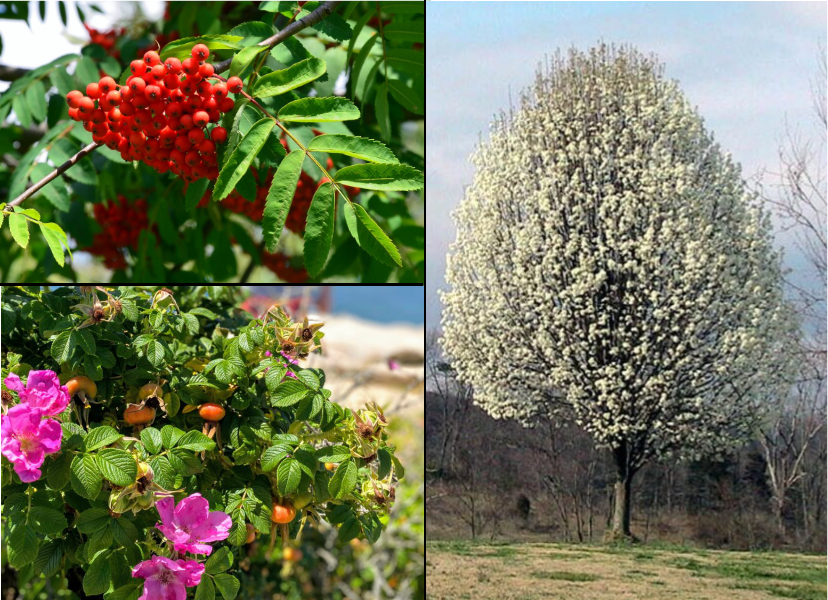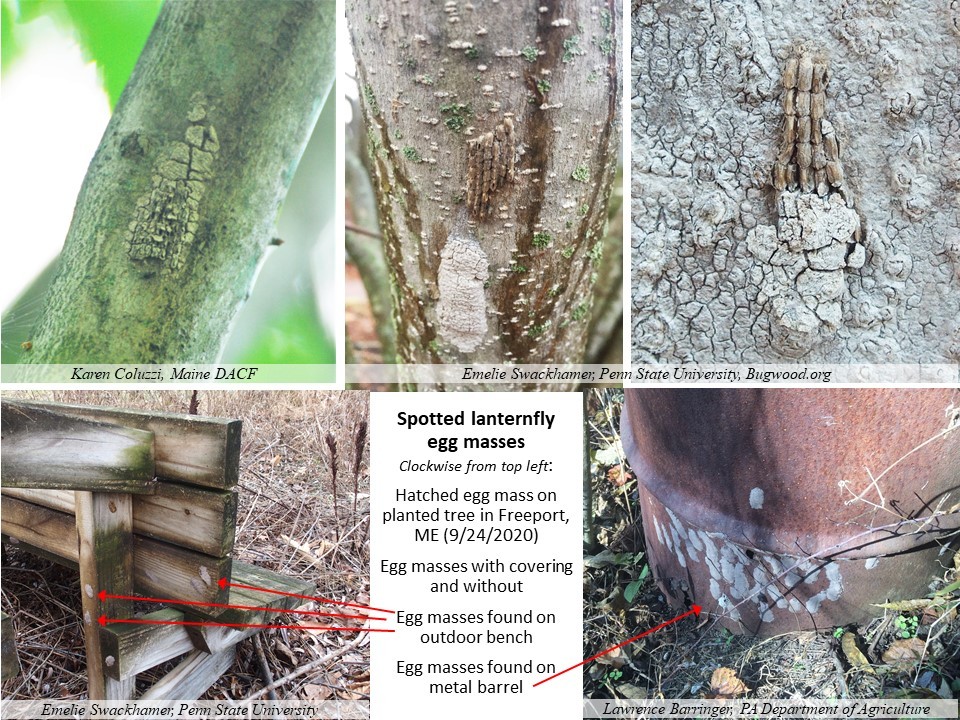MELeaf: A Newsletter From the Horticulture Program, April 13, 2022
In this issue:
 Clockwise from top left: European mountain ash, callery pear and rugosa rose. All three plants are included in proposed invasive plant rules. Photo credits: Silar, commons.wikimedia.org, CE Price pixnio.com, Cncrsnet commons.wikimedia.org
The Department of Agriculture, Conservation and Forestry is currently seeking comments on adding 30 plants to the terrestrial invasive plant do-not-sell list and other amendments to the invasive plant rule.
While we recognize that the timing of the comment period for this rule is falling during a busy season, it is important that we hear from you. The only way for us to know how the rule affects you and your business is if you tell us.
Proposed changes to the rule include:
- Adding 30 species to the current list of 33 species on the “Do-Not-Sell List."
- Creating and adding 29 species to a “Watch List.” These species can continue to be sold in the state, but may have some invasive potential and will be re-evaluated first in the next 5 year review of the rules.
- Create a new category for “Species of Special Concern.” Rosa rugosa is the only plant currently being proposed for this category. Plants in this category can be sold, but the seller will have to provide information that the plant may be invasive in certain habitats. The proposed rule includes two options, one requiring individual plants be tagged and the other that a sign be displayed with the plants. The Plant Health Program requests that commenters indicate which option is their preference.
- Additional changes to the rule include changes and additions to definitions and better describing the variance process.
More information including the proposed rule changes and lists of plants
How to comment:
-
In-Person at the Public Hearing: Friday, April 22, 2022 from 10:00 AM to 12:00 PM in Room 101 of the Deering Building at 90 Blossom Lane in Augusta, Maine.
-
Virtually at the Public Hearing: A virtual option is also being offered for providing comments during the hearing on Friday, April 22, 2022 from 10:00 AM to 12:00 PM. Join on your computer or mobile app (Microsoft Teams) Or call in (audio only): +1 207-209-4724, Phone Conference ID: 670 518 716#
-
Written Comments: Written comments will be taken until 5:00 PM, Friday, May 6, 2022. Written comments should be emailed or mailed to Gary Fish, Maine DACF, 28 SHS, Augusta, ME 04333-002.
As we rapidly approach the spring sales season, the Horticulture Program is aware of reports of two diseases in the supply chain this year that could cause plant losses in some important crops. Some of you may have received a letter from a supplier alerting you that you may have received geranium plants infected with Xanthomonas (bacterial blight of geranium) or a letter about potential calibrachoa plants infected with chili pepper mild mottle virus (CPMMoV). In cases like this it is important that you follow the instructions provided by the supplier in order to receive compensation. However, you should also reach out to Horticulture Program staff who can assist you in identifying affected plants, taking plant samples for testing (if necessary) and help identify any additional steps you can and should take to prevent any diseases from spreading.
Xanthomonas, Bacterial Blight of Geranium
Xanthomonas blight of geranium is usually introduced in cuttings and then easily spreads through out a crop in irrigation water, especially when infected hanging baskets drip on the crop below or geraniums are grown on flood benches, and on hands and tools when cleaning and trimming plants. Symptoms start as small water soaked spots that turn into tan/brown spots then enlarge into wedge shaped areas of yellowing and necrosis, eventually the plant will wilt and die. Xanthomonas requires specific environmental conditions and plants may be infected for months before expressing symptoms; it is important to continually scout plants for new symptoms especially as temperatures warm in the spring. There are no effective chemical controls for Xanthomonas. Prevention is key. Avoid placing geranium (including ivy geranium) hanging baskets over geranium crops, avoid growing geraniums on flood benches and do not recycle irrigation water, keep plants from different suppliers separated, frequently clean hands and tools when cleaning plants and if symptoms are observed have plants immediately tested (and don't handle plants while waiting for any test results!).
More information on Xanthomonas
Pictures of infected plants
Chili Pepper Mild Mottle Virus
Chili pepper mild mottle virus is a new virus and is not yet well understood. It is in the tobamovirus group like tobacco mosaic virus (TMV) and like TMV, is probably spread on hands and tools, but does not appear to be spread by insects. The full host range is not yet known but most solanaceous (calibrachoa, petunia, tomato, pepper, eggplant etc.) crops are probably affected. Look for mottling, irregular flower color patterns and stunting. Good sanitation practices will help prevent disease from spreading: wash hands and tools often, rogue and destroy plants with symptoms, avoid handling healthy plants after diseased plants and disinfect benches and other surfaces between crops.
More information on CPMMoV including pictures
Spotted lanternfly (SLF) will lay eggs on any surface, including nursery stock. Check incoming plant material as it is received in the spring for any signs of SLF egg masses. Report any suspicious find by taking a picture and sending it to horticulture@maine.gov.
More Information about SLF
Best Management Practices to Prevent Introducing SLF for Greenhouses and Nurseries developed by New Hampshire Department of Agriculture, Markets & Food
Spotted Lanternfly and Nursery Stock Massachusetts Department of Agriculture Blog Post


|